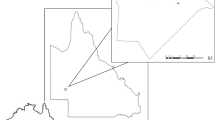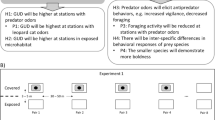Abstract
Prey may recognize and respond to predatory cues based on a period of co-evolution or life experience with a predator. When faced with a novel predator, prey may be naïve to the threat posed and/or unable to respond effectively, making them highly susceptible to predation. Burrowing bettongs (Bettongia lesueur) are one such species whose naïveté towards introduced predators has contributed to their extinction from mainland Australia. Here, we asked whether bettongs that were predator-naïve and bettongs which had been exposed to feral cats (Felis catus) for up to 2 years could discriminate between odors of a predator with which they shared no evolutionary history (feral cats), a predator with which they share a deep evolutionary history (Tasmanian devil—Sarcophilus harrisii), a novel herbivore (guinea pig—Cavia porcellus), and procedural control (a towel moistened with deionized water). We deployed scents at foraging trays and filmed bettongs’ behavior at the trays. Predator-naïve bettongs’ latency to approach foraging trays and behavior did not differ between scents. Cat-exposed bettongs increased their latency to approach in the presence of animal scents compared with control, and approached predatory scents slowly and cautiously more often than herbivore and procedural control scents. Taken together, these results suggest that bettongs have not retained anti-predator responses to Tasmanian devils after 8000 years of isolation from mammalian predators but nevertheless show that bettongs exposed to predators are more wary and may be able to generalize predator response using olfactory cues.
Significance statement
When prey encounter a novel predator, they are often naïve to the threat posed and employ ineffective anti-predator responses, because they lack either evolutionary or ontogenetic experience with the predator. Determining how prey identify novel predators is important to improve the success of translocations and reintroductions. Here, we examine how exposure of predator-naïve individual burrowing bettongs to predators influences anti-predator responses. By quantifying bettong responses to odors, we show that those experimentally exposed to cats increased their vigilance in response to odors from cats and Tasmanian devils. The results are consistent with the idea that prey generalize anti-predator responses based on non-specific compounds found in predatory odors, and that exposure to novel predators can improve anti-predator responses.



Similar content being viewed by others
References
Abbott I (1979) Aboriginal man as an exterminator of wallaby and kangaroo populations on islands round Australia. Oecologia 44:347–354
Alder GH, Levins R (1994) The island syndrome in rodent populations. Q Rev Biol 69:473–490
Anson J, Dickman C (2013) Behavioral responses of native prey to disparate predators: naïveté and predator recognition. Oecologia 171:367–377
Apfelbach R, Blanchard CD, Blanchard RJ, Hayes RA, McGregor IS (2005) The effects of predator odors in mammalian prey species: a review of field and laboratory studies. Neurosci Biobehav Rev 29:1123–1144
Berger J, Swenson JE, Persson I (2001) Re-colonising carnivores and naive prey: conservation lessons from Pleistocene extinctions. Science 291:1036–1039
Biggins DE, Vargas A, Godbey JL, Anderson SH (1999) Influence of pre-release experience on reintroduced black-footed ferrets (Mustela nigripes). Biol Conserv 89:121–129
Blumstein DT (2002) Moving to suburbia: ontogenetic and evolutionary consequences of life on predator-free islands. J Biogeogr 29:685–692
Blumstein DT, Barrow L, Luterra M (2008) Olfactory predator discrimination in yellow-bellied marmots. Ethology 114:1135–1143
Blumstein DT, Daniel JC (2005) The loss of anti-predator behaviour following isolation on islands. Proc R Soc Lond B 272:1663–1668
Blumstein DT, Daniel JC, Mclean IG (2001) Group size effects in quokkas. Aust J Zool 49:641–649
Blumstein DT, Daniel JC, Springett BP (2004) A test of the multi-predator hypothesis: rapid loss of antipredator behavior after 130 years of isolation. Ethology 110:919–934
Brown GE, Ferrari MCO, Malka PH, Russo S, Tressider M, Chivers DP (2011) Generalization of predators and nonpredators by juvenile rainbow trout: learning what is and is not a threat. Anim Behav 81:1249–1256
Brown JS, Kotler BP (2004) Hazardous duty pay and the foraging cost of predation. Ecol Lett 7:999–1014
Caro T (2005) Anti-predator defenses in birds and mammals. The University of Chicago Press, Chicago
Carthey AJR, Blumstein DT (2018) Predicting predator recognition in a changing world. Trends Ecol Evol 33:106–115
Christensen P, Burrows N (1995) Project desert dreaming: experimental reintroduction of mammals to the Gibson Desert, Western Australia. In: Armstrong DP, Hayward MW, Moro D, Seddon PJ (eds) Advances in reintroduction biology of Australia and New Zealand Fauna CSIRO Publishing, Clayton South VIC, pp 199–207
Cox JG, Lima SL (2006) Naïveté and an aqautic-terrestrial dichotomy in the effects of introduced predators. Trends Ecol Evol 21:674–680
Ferrari MCO, Crane AL, Chivers DP (2016) Certainty and the cognitive ecology of generalization of predator recognition. Anim Behav 111:207–211
Ferrari MCO, Gonzalo A, Messier F, Chivers DP (2007) Generalisation of learned predator recognition: an experimental test and framework for future studies. Proc R Soc Lond B 274:1853–1859
Ferrero DM, Lemon JK, Fluegge D, Pashkovski SL, Korzan WJ, Datta SR, Spehr M, Fendt M, Liberles SD (2011) Detection and avoidance of a carnivore odor by prey. P Natl Acad Sci USA 108:11235–11240
Finlayson GR, Moseby KE (2004) Managing confined populations: the influence of density on the home range and habitat use of reintroduced burrowing bettongs (Bettongia lesueur). Wildlife Res 31:457–463
Fishman MA (1999) Predator inspection: closer approach as a way to improve assessment of potential threats. J Theor Biol 196:225–235
FitzGibbon CD (1994) The costs and benefits of predator inspection behaviour in Thomson’s gazelles. Behav Ecol Sociobiol 34:139–148
Friard O, Gamba M (2016) BORIS: a free, versatile open-source event-logging software for video/audio coding and live observations. Methods Ecol Evol 7:1324–1330
Gale SJ (2009) Event chronostratigraphy: a high-resolution tool for dating the recent past. Quat Geochronol 4:391–399
Geoscience Australia (2017) Compute sunrise, sunset & twilight times, http://www.ga.gov.au/geodesy/astro/sunrise.jsp
Griffin AS, Blumstein DT, Evans CS (2000) Training captive-bred or translocated animals to avoid predators. Conserv Biol 14:1317–1326
Griffin AS, Evans CS, Blumstein DT (2001) Learning specificity in acquired predator recognition. Anim Behav 62:577–589
IBM corp (2014) IBM SPSS Statistics for Windows, Version 23.0. IBM Corp., Anmonk, NY
Lewis SE, Sloss CR, Murray-Wallace CV, Woodroffe CD, Smithers SG (2013) Post-glacial sea-level changes around the Australian margin: a review. Quat Sci Rev 74:115–138
Lima SL, Dill LM (1990) Behavioral decisions made under the risk of predation: a review and prospectus. Can J Zool 68:619–640
McLean IG, Lundie-Jenkins G, Jarman PJ (1996) Teaching an endangered mammal to recognise predators. Biol Conserv 75:51–62
McLean IG, Schmitt NT, Jarman PJ, Duncan C, Wynne CDL (2000) Learning for life: training marsupials to recognise introduced predators. Behaviour 137:1361–1376
Moseby K, Carthey AJR, Schroeder T (2015a) The influence of predators and prey naivety on reintroduction success: current and future directions. In: Armstrong D, Hayward M, Moro D, Seddon PJ (eds) Advances in reintroduction biology of Australian and New Zealand fauna. CSIRO Publishing, Melbourne, Australia, pp 29–42
Moseby KE, Blumstein DT, Letnic M (2015b) Harnessing natural selection to tackle the problem of prey naïveté. Evol Appl 9:334–343
Moseby KE, Letnic M, Blumstein DT (2018b) Designer prey: can controlled predation accelerate selection for anti-predator traits in naïve populations? Biol Conserv 217:213–221
Moseby KE, Lollback GW, Lynch CE (2018a) Too much of a good thing; successful reintroduction leads to overpopulation in a threatened mammal. Biol Conserv 219:78–88
Moseby KE, Read JL, Paton D, Copley P, Hill BM, Crisp HA (2011) Predation determined the outcome of 10 reintroduction attempts in arid South Australia. Biol Conserv 144:2863–2872
Nolte DL, Mason JR, Epple G, Aronov E, Campbell DL (1994) Why are predator urines aversive to prey? J Chem Ecol 20:1505–1516
Novosolov M, Raia P, Meiri S (2013) The island syndrome in lizards. Glob Ecol Biogeogr 22:184–191
Nunes AL, Orizaola G, Laurila A, Rebelo R (2014) Rapid evolution of constitutive and inducible defenses against an invasive predator. Ecology 95:1520–1530
Osada K, Miyazono S, Kashiwayanagi M (2015) The scent of wolves: pyrazine analogs induce avoidance and vigilance behaviors in prey. Front Neurosci 9:363
Parks H, Clifton K, Best L, Johnson B (2012) Now that we have our pest-proof fence, are we safe or trapped? Pac Conserv Biol 18:77–80
Parsons MH, Apfelbach R, Banks PB, Cameron EZ, Dickman CR, Frank ASK, Jones ME, McGregor IS, McLean S, Müller-Schwarze D, Sparrow EE, Blumstein DT (2018) Biologically meaningful scents: a framework for understanding predator–prey research across disciplines. Biol Rev 93:98–114
Ride WDL, Mees GF, Douglas AM, Royce RD, Tyndale-Biscoe CH (1962) The results of an expedition to Bernier and Dorre Islands, Shark Bay, Western Australia in July 1959. Government Printer, Perth
Short J (2009) The characteristics and success of vertebrate translocations within Australia. Wildl Res and Management Pty Ltd., Kalamandu, WA, Australia
Short J, Smith A (1994) Mammal decline and recovery in Australia. J Mammal 75:288–297
Short J, Turner B (1993) The distribution and abundance of the burrowing bettong (Marsupialia: Macropoidea). Wildlife Res 20:525–533
Short J, Turner B (2000) Reintroduction of the burrowing bettong Bettongia lesueur (Marsupialia: Potoroidae) to mainland Australia. Biol Conserv 96:185–196
Shortridge GC (1910) Account of the geographical distribution of the marsupials and monotremes of south-west Australia, having special reference to the specimens collected during the Balston expedition of 1904-1907. P Zool Soc Lond 55:803–848
Stingemore JL (2010) Surviving the “cure”: life on Bernier and Dorre islands under the lock hospital regime. PhD thesis, University of Western Australia
Van Heezik Y, Seddon PJ, Maloney RF (1999) Helping reintroduced houbara bustards avoid predation: effective anti-predator training and the predictive value of pre-release behaviour. Anim Conserv 2:155–163
Webb JK, Du WG, Pike DA, Shine R (2009) Chemical cues from both dangerous and nondangerous snakes elicit antipredator behaviours from a nocturnal lizard. Anim Behav 77:1471–1478
West R, Letnic M, Blumstein DT, Moseby KE (2018) Predator exposure improves anti-predator responses in a threatened mammal. J Appl Ecol 55:147–156
White THJ, Collazo JA, Vilella FJ (2005) Survival of captive-reared Puerto Rican parrots released in the Caribbean National Forest. Condor 107:424–432
Woinarski JCZ, Burbidge AA, Harrison PL (2015) Ongoing unraveling of a continental fauna: decline and extinction of Australian mammals since European settlement. P Natl Acad Sci USA 112:4531–4540
Acknowledgments
We thank the Arid Recovery staff and volunteers for their help with this study. We thank the two anonymous reviewers whose comments and suggestions helped improve and clarify this manuscript.
Funding
Funding for this project was provided by the Australian Research Council.
Author information
Authors and Affiliations
Corresponding author
Ethics declarations
Conflict of interest
The authors declare that they have no competing interests.
Ethical approval
All applicable international, national, and/or institutional guidelines for the care and use of animals were followed. The work was conducted under the UNSW animal ethics (APEC Approval 15/19A) and in accordance with The Australian Code of Practice for the Care and Use of Animals for Scientific Purposes (1997).
Additional information
Communicated by A. I. Schulte-Hostedde
Rights and permissions
About this article
Cite this article
Saxon-Mills, E.C., Moseby, K., Blumstein, D.T. et al. Prey naïveté and the anti-predator responses of a vulnerable marsupial prey to known and novel predators. Behav Ecol Sociobiol 72, 151 (2018). https://doi.org/10.1007/s00265-018-2568-5
Received:
Revised:
Accepted:
Published:
DOI: https://doi.org/10.1007/s00265-018-2568-5




